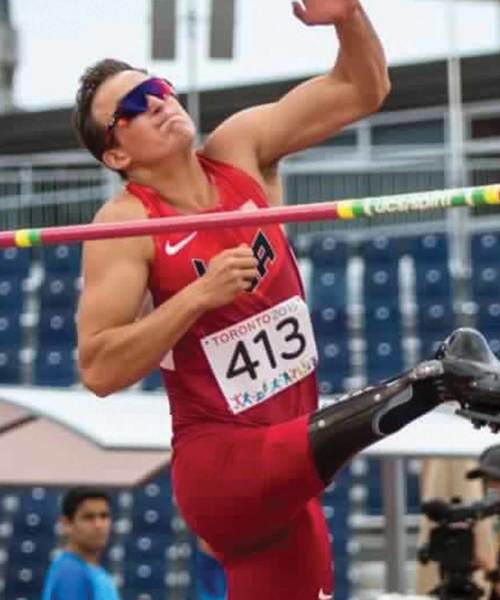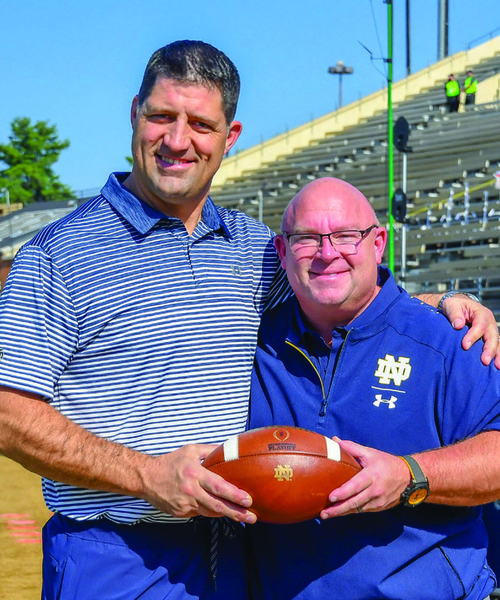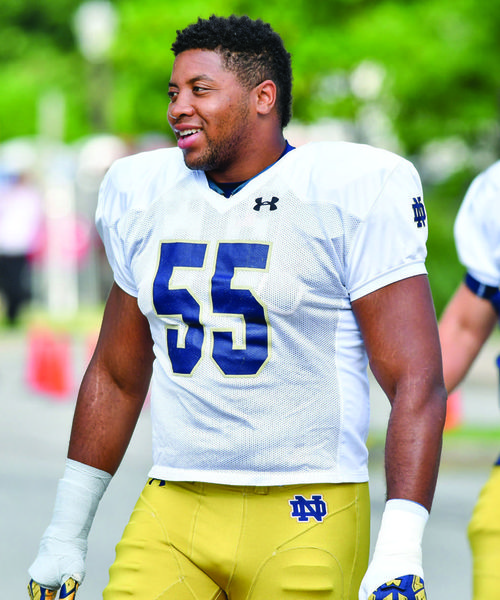
Sam Grewe
Grewe Crew
About the toughest decision most seventh-graders face as they move through junior high school is whether or not to ask that special someone to the school dance.
For a particular seventh-grader back in 2012, the decision he faced was whether to fight the cancer in his right leg and save the limb or have it amputated and start a new life with a prosthetic.
Surprisingly and seemingly contradictorily, a passion for sports made this scary choice for Sam Grewe a relatively easy one.
Grewe—now a University of Notre Dame freshman, a cancer survivor, an inspiration and so much more—chose amputation.
"The artificial joints they would have had to put in would be too fragile for me to ever return to sports," Grewe explains of his doctor's warning. "So I decided to go with the amputation just to provide even the slightest option, the slightest possibility, of a return to athletics."
Less than six months before his life-changing choice, Grewe was a healthy and hearty multi-sport athlete at Northridge Middle School in Middlebury, Indiana. He had just completed his football season as the team's best player and was about halfway through his basketball season when pain began to shoot randomly and intensely through his leg just above his right knee.
Growing pains or maybe a stress fracture—those were the logical assumptions from family, coaches, friends and even Grewe himself. So when a routine checkup on Christmas Eve 2011 brought a diagnosis of a rare bone cancer called osteosarcoma, the Grewes’ world stopped turning.
"One x-ray showed a fist-size tumor against my femur—it was eating away at my femur," Sam recalls of the unforgettable image. "You think your life is over. You're a healthy athlete and then everything is cut short, just like that."
The difficult treatment options of either limb salvation or amputation were presented, and with the input from his parents, Randy and Michelle Grewe, after their extensive research, Sam Grewe chose a proven but complex amputation procedure called rotationplasty surgery, a difficult decision Sam amazingly still calls the most liberating one of his life.
During rotationplasty, a portion of Sam's infected right leg was removed from just above his knee down to slightly below the calf muscle. The healthy lower portion of his ankle and foot was then rotated 180 degrees and reattached to where the leg had been amputated at the femur.
Essentially, Grewe's ankle lined up at knee level with his healthy left leg and his foot faced backward to provide an increased flexibility for use with the prosthetic. It's a revolutionary procedure that is allowing many patients, young and old, to stay active and even competitive in athletics.
"Sam said he didn't want to grow up and be a lazy old man," Michelle Grewe says. "He wanted to be a dad that could go out and play with his kids. This was a strange observation for a seventh-grader, but it was just his way of saying he wanted to be active."
Make no mistake, the choice to amputate was not made on whim. Sam Grewe's parents left nothing to chance before giving their blessing, somewhat reluctantly.
"We really leaned toward limb salvation. He's just a kid and we wanted him to be as normal as he can be," Michelle recalls. "Even though rotationplasty has the potential to lead to a lot of success, if done wrong, like any surgery, you're going to have problems."
Randy and Michelle Grewe faced many long and late nights surfing the Internet or consulting with other families familiar with rotationplasty.
Finding the right doctor was also critical, and the Grewes put their confidence in Dr. Lawrence Wertz—an experienced orthopedics surgeon at Riley Hospital for Children in Indianapolis—who was familiar with this intricate surgical procedure.
Sam said surviving the treatments, confusion and inactivity in the months before and after the surgery were worse than the amputation itself. The chemotherapy treatments were aggressive and debilitating, each landing Grewe back in a hospital room for at least a week.
"Pretty much bed-ridden," he says, "super sick."
The treatment schedule meant spending at least a week in the hospital during and after chemo, then a week home for recovery, back to the hospital for another session, back out again, back in and so on.
"The next three months or so were a dark place, and chemo was the worst, by far the worst, of the entire process," Grewe says. "Just trying to figure everything out, trying to understand exactly what was happening and what was going to happen."
Sam Grewe underwent 21 chemotherapy treatments for 18 months through almost all of 2012 and most of 2013. He spent more than 200 days and nights inside South Bend Memorial Hospital feeling weak, nauseous and scared, and he admits now that without family, community and ultimately Notre Dame football, his difficult recovery would've bordered on impossible.
A chance meeting in the hospital between Grewe and a Notre Dame football administrator sparked a relationship that became the roots to one of the most touching stories in Irish football history.
As the director of player development and engagement at Notre Dame in 2012 and 2013, Ernest Jones spent much of his time helping Irish student-athletes become involved in the community through a program called Athletes Around the Bend.
Jones' work frequently brought him to Memorial Hospital where his meeting with Grewe during a chemo treatment gave the football coach a chance to lift the spirits of an ailing child and inspire a football team at the same time.
Just two days before his amputation surgery at Riley Hospital, Grewe was invited by the Notre Dame football family to become an honorary team member of the 2012 Irish football team. This became a symbiotic relationship that helped a seventh-grader beat cancer and a football team play for a national championship.
"It meant everything," Grewe says of the open invitation that included full access that magical season to all things Notre Dame football. "I can't imagine where I'd be now if that hadn't happened. It offered inspiration for the players. It offered motivation for me. It pushed me to set higher goals that I didn't think were possible."
Grewe admits to being shy and intimidated when he first started hanging out with the guys and attending football functions. After all, here was a young star athlete and healthy teenager from just a few months earlier who was now bald and a shell of himself physically.
"I'm just this little skeleton of what I once was," Grewe remembers of his first team meal with the guys, only a couple of days before his trip to Indianapolis for his amputation. "I'm just this little, skinny, 13-year-old cancer victim sitting with these giant healthy men. I was very intimidated."
A few weeks after the surgery, and while still adapting to his new prosthetic, Grewe returned to Notre Dame and was greeted inside the football auditorium with an emotional standing ovation from all the Irish players, each wearing "Grewe Crew" T-shirts and wristbands with the slogan "We Play for Sam"—a united effort to show support, respect and appreciation for this courageous young man.
Notre Dame head coach Brian Kelly remembers that day well.
"Collectively, our team adopting him," Kelly says, "he did more good for our players in the sense that it wasn't hard to go out there and practice and show grit, show determination and toughness after what this young man had gone through."
This special day marked a journey that was only beginning for both a football team on a season's mission and a young man on a life's mission.
The surgery was complete, but the recovery for Grewe was a long time coming. Chemotherapy was still part of his rehab routine, but it was not invasive enough to interfere with his new-found love of Notre Dame football and an insistence to stay attached to it.
"We by no means understood the magnitude of the impact this relationship with the team would have on Sam," Michelle Grewe says. "It became a strong motivation for him getting up, getting out of bed, getting healthy. It might have been a Saturday game, and we'd get out of the hospital on Friday after a week of chemo. If we would've been home, he would've been on the couch all weekend, understandably so, but we'd load up the vehicle, he'd puke a few times and he'd be ready to go because he had that motivation to get out there with the team."
Michigan State, Michigan, Miami, Stanford, Oklahoma … six in a row, seven in a row, eight, nine—the big wins kept coming for Notre Dame during that undefeated regular season and Sam was on the sideline and in the locker room for every home game as players such as Manti Te'o, Mike Golic Jr., Joe Schmidt, Matthias Farley and so many others shared all the moments and joy with their adopted teammate.
"I could see the excitement that these guys were experiencing," Sam says, "total joy that the team was doing so well. And I kinda felt like I was part of the team. I felt undefeated that season, too."
Nothing got in the way of Sam Grewe's passion for Irish football. As part of his game-day routine, Grewe would often haul around on the sidelines a 10-pound backpack loaded with the necessary IV fluids to be dripped during the game.
"He's just one of the boys, he's a great dude," Schmidt remembers. "So I think just seeing how he's kind of overcome his obstacles makes any of ours look like child's play."
Indeed, Grewe became one of the boys, serving as an honorary team captain one game for the coin toss, leading the team in a postgame song and celebration after an important win on Senior Day and just enjoying the little things that came along with this big season.
"I was very entrenched," Sam says. "It got to the point where I was talking to the players every day."
The 2012 season ended with a trip to Miami and a spot in the national championship game and, of course, Sam Grewe and his family were there for all of it. Sam's sister Audrey is now a senior at Notre Dame, majoring in film, television and theatre and working on a documentary about her brother.
And while the memories of Notre Dame's difficult loss to Alabama in the title game have faded with time, the relationships, experiences and lessons of that season have not.
"That season built a foundation for me to succeed while also showing the players not to take things for granted, not to take their situation for granted and to appreciate where they are," is how Grewe sums up his season with the team. "It also was building a foundation for me to succeed. It just naturally occurred."
Now 19 years old, Sam Grewe and his recovery have come and gone a long way since his amputation surgery almost six years ago.
Grewe earned a spot on his basketball team at Northridge High School. He also took up lacrosse, and he eventually joined his high school track and field team as a high-jumper, quickly becoming a very good one.
So good, in fact, that in less than two years competing and under the tutelage of Goshen College (Indiana) track coach Kyle Mishler, Grewe went from a newbie in the event, to a 2015 U.S. Paralympic National Team member, then to a World Championships qualifier in Doha, Qatar, then to a stunning gold medalist in those World Championships as the youngest and lowest-seeded participant at the meet.
"That was actually the biggest step in doing what I do because that made me realize there is a future. I could be one of the best," says Grewe, still filled with amazement at his overnight success. "It was very unexpected."
Grewe's winning jump at the World Championships of 1.81 meters (5.94 feet) in the T42 event (above the knee amputees) shattered his personal best by five inches and vaulted him onto the international scene and into a spot on the U.S. National Team for the 2016 Paralympic games in Rio de Janeiro, Brazil.
"Everything kind of clicked for him right then at the right time," Mishler says.
Grewe made good again and followed his surprising gold medal at the World Championships with a silver medal at the Rio games with a jump of 1.86 meters (6.10 feet).
Beaming with confidence, Grewe returned to international competition this fall at the 2017 World Championships in London and struck more gold, matching his Rio jump of 1.86 meters.
Less than four years of big-time competition, three international events, two golds, one silver and endless potential, so what's next?
Mishler explains that 2018 is a "down year" for premier Paralympic track meets, but Grewe will train and compete in some national events with the purpose of reaching a standard height in order to keep funding in place from the United States Olympic Committee for his training.
From there, Grewe has his sites set on a world record in 2019, a mark set at 1.95 meters (6.40 feet). Grewe's official PR is listed at 1.86 meters (6.10 feet), but Mishler watched Grewe clear 1.93 meters (6.33 feet) in high school and is certain his dedicated pupil can eclipse the world-record height with more time and training.
"Sam's mental toughness is far beyond his years," Mishler says. “That toughness has helped him tremendously in everything he has done after beating cancer. He never thinks of himself as having a disability and that's why he just continues to get better and better."
Suffice it to say Sam Grewe will never become the lazy old man he had no interest in evolving into when he made the tough choice to give up part of his leg to keep his life whole.
Grewe admits that being a first-year pre-med major at a prestigious university such as Notre Dame—studying oncology, of course—is every bit as difficult as would be expected.
But we're talking about Sam Grewe, so is there any reason to think he won't survive and excel after everything he has already conquered?
"Throughout this entire story there has been a lot of fear, fear of what's going to happen next, fear of the future," Grewe says in reflection.
"I think persistence is the biggest thing I've learned. Persistence and using a great mindset and staying positive can bring an outcome that you couldn't have expected.
“Where I am now I would never in a million years go back and change. "

